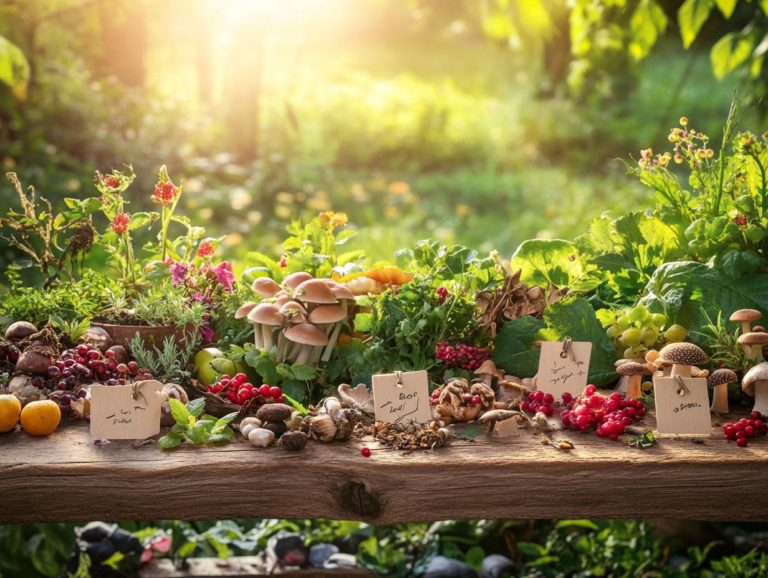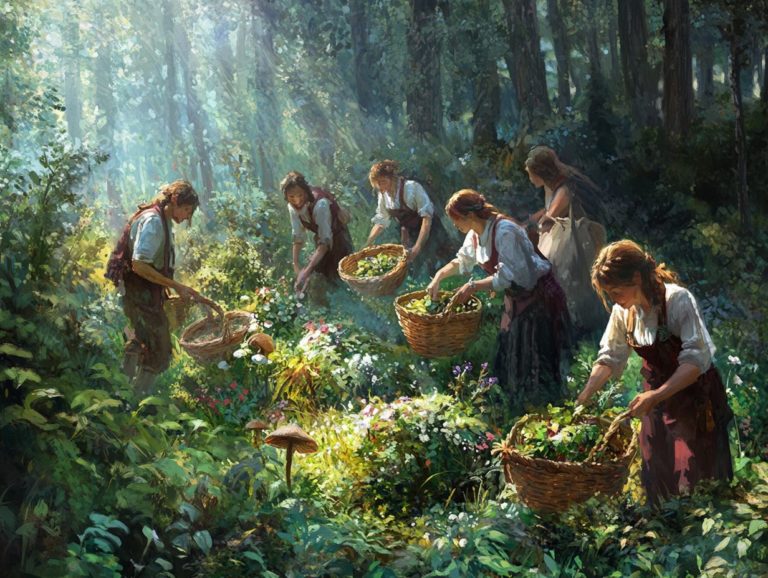How to Use Foraging Techniques in Cooking
Foraging connects you to nature in a rewarding way. It offers the thrill of discovery along with the promise of fresh, nutritious food.
This exploration into foraging will guide you in identifying edible plants and fungi, equip you with essential tools, and share safe harvesting techniques and guidelines to boost your confidence.
You ll also discover delicious recipes that incorporate your foraged finds, making your culinary adventures delightful and unique.
Important safety tips, including considerations for gathering wild plants, will be highlighted throughout to keep your foraging experiences enjoyable and safe.
Get ready to embrace the wild bounty around you!
Contents
- Key Takeaways:
- What is Foraging and Its Benefits?
- Identifying Edible Plants and Fungi
- Foraging Tools and Equipment
- Harvesting and Storing Foraged Foods
- Incorporating Foraged Foods in Cooking
- Safety Precautions and Considerations
- Frequently Asked Questions
- What are foraging techniques in cooking, and how do they relate to wild plants?
- Why should I use foraging techniques in cooking?
- How do I start using foraging techniques in cooking?
- What are some common mistakes to avoid when using foraging techniques in cooking?
- Can I forage for ingredients all year round?
- Are there any safety precautions I should take when using foraging techniques in cooking?
Key Takeaways:

- Foraging can provide a variety of health benefits, including increased nutrient intake and exposure to natural environments.
- It is important to properly identify and harvest edible plants and fungi using reliable sources and tools.
- Incorporating foraged foods in cooking can add unique flavors and textures to dishes, while safety precautions should always be taken to avoid potential hazards.
What is Foraging and Its Benefits?
Foraging is the art of seeking out and gathering wild plants, including wild fruits, herbs, and fungi from their natural habitats. To enhance your skills, refer to this seasonal guide on foraging techniques, which serves both cooking and medicinal purposes.
When you engage in foraging, you deepen your connection to local ecosystems and embrace a sustainable lifestyle by utilizing edible plants like wild fruits and herbs. This practice offers significant health benefits and encourages mindfulness and appreciation for biodiversity.
Identifying Edible Plants and Fungi
Identifying edible plants and fungi is essential for anyone venturing into foraging since misidentification can pose health risks.
By enrolling in plant identification and herbalism courses (study of plants for medicinal use), you can master distinguishing safe wild foods, such as wild blueberries and edible mushrooms, from their toxic counterparts. This knowledge enhances your foraging experience and ensures that your culinary explorations are both safe and rewarding.
Common Edible Plants and Fungi
Common edible plants and fungi you might seek out include wild mushrooms, wild fruits like chokecherries, and aromatic herbs such as wild basil and mint. Each provides unique flavors and health benefits.
These foraged treasures elevate your culinary experiences and offer nutrients and medicinal properties. For instance, wild mushrooms can be rich in vitamins and minerals, while chokecherries are loaded with antioxidants that support overall health. Aromatic herbs like wild basil and mint enhance dishes with distinct flavors and aid digestion.
Exercise caution when foraging, as some edible plants have toxic look-alikes. Familiarizing yourself with reliable guidelines and consulting expert resources will ensure your foraging adventures are safe and enjoyable.
Foraging Tools and Equipment

Equipping yourself with the right tools is crucial for a successful foraging adventure. These essentials enhance your techniques and ensure a safe experience in the wild.
Your toolkit should include:
- A sharp foraging knife
- A sturdy harvest basket
- A reliable field guide for plant identification
- A first aid kit to handle minor injuries that might occur while exploring nature
With the right gear, you re well-prepared to embrace the wonders of foraging. Start exploring your local area for edible plants today!
Essential Gear for Successful Foraging
- Durable harvest basket for collecting wild foods
- Reliable field guide for accurate plant identification
- Well-stocked first aid kit to handle minor injuries
Having the right gear enhances your foraging adventures and fosters a deeper appreciation for the local ecosystem.
A sturdy harvest basket keeps your gathered treasures intact and fresh, minimizing waste. The right field guide is invaluable, especially in areas with diverse flora; it gives you the power to confidently identify edible plants while steering clear of their toxic look-alikes.
Don t forget about your first aid kit it s essential for addressing minor injuries or allergic reactions while you explore the wilderness.
For sourcing these tools, visit local outdoor shops, community garden centers, and herbalists. They often have an excellent selection and may offer workshops to help you hone your foraging skills and deepen your understanding of sustainable practices.
Harvesting and Storing Foraged Foods
Harvesting and storing foraged foods requires a careful strategy that keeps nature thriving and your foraging plentiful.
Embracing foraging guidelines is crucial. It helps preserve plant communities and fosters the ongoing growth of wild foods like wild carrots and highbush cranberries, ensuring sustainable practices.
Proper Techniques and Best Practices
Understanding sustainable harvesting methods, following foraging guidelines, and respecting the ecosystems you explore are essential for successful foraging.
By adopting a mindful approach, you ensure that you’re not depleting resources while savoring nature’s bounty. For example, when harvesting wild herbs, it s wise to take only a small percentage from each plant, allowing it to thrive.
For gathering mushrooms, use a knife to cut the stem at the base instead of yanking the whole fungus out, which helps preserve the mycelium, the underground part of mushrooms that helps them grow.
Many seasoned foragers recommend leaving certain plants and fungi untouched during peak seasons to maintain ecological balance and promote healthy growth for future generations.
Incorporating Foraged Foods in Cooking

Incorporating foraged foods into your cooking can elevate your culinary experiences. To enhance your knowledge, learn how to use local resources for sustainable foraging. Unique flavors transform your meals and infuse your wild food adventures with excitement.
From the rich earthiness of wild mushrooms to the fragrant notes of aromatic herbs, countless creative recipes await you, designed to highlight the essence of edible plants.
Creative and Delicious Recipes
Exploring creative and delicious recipes with foraged ingredients can elevate any meal into a remarkable wild food adventure, especially when you apply the top foraging techniques for beginners.
Whether it s the earthy allure of wild mushrooms or the peppery zing of dandelion greens, each dish presents a unique taste profile that deepens your connection to the land.
Incorporating ingredients like nettles, ramps, and elderflowers not only enhances your meals but also provides nutritional benefits from these wild plants and fungi.
With guidance from experienced foragers like Darcy Williamson and John Kallas and a spirit of experimentation, your kitchen can transform into a vibrant playground where everyday meals acquire exciting new dimensions, especially when you explore the most popular foraging recipes.
Safety Precautions and Considerations
When foraging, prioritizing safety precautions is key. The risks posed by poisonous plants, like some species of wildflowers, can seriously threaten your well-being.
By understanding key safety considerations and adhering to established foraging guidelines, you can turn your outdoor exploration into a safe and enjoyable adventure, fully immersed in the wonders of nature.
Start your foraging journey today! Gather your gear and dive into the world of wild foods.
Avoiding Poisonous Plants and Contamination
Avoiding poisonous plants and contamination is essential for anyone keen on foraging. Mistaking one plant for another can lead to serious health risks. It s crucial to follow established safety considerations and foraging guidelines.
To effectively navigate the world of wild edibles, you should familiarize yourself with visual signs that help you identify safe plants. Understanding specific leaf shapes, flower colors, and growth patterns will significantly aid your identification skills, especially when distinguishing between various wild plants.
Be mindful of common pitfalls, such as harvesting near polluted areas or water sources like Riggins, Idaho, where plants may absorb harmful substances. Always ensure that any foraged foods are thoroughly rinsed to remove dirt and potential pesticides. It’s wise to verify your finds with reliable resources or local experts before consumption.
By adhering to these practices, you can enjoy the rewarding experience of foraging while minimizing health risks and nurturing respect for nature. Get ready to explore the fantastic world of wild edibles!
Frequently Asked Questions

What are foraging techniques in cooking, and how do they relate to wild plants?
Foraging techniques in cooking involve finding and harvesting wild ingredients from nature to use in dishes. Learning how to use foraging in culinary arts can include anything from edible plants and herbs to wild game and mushrooms.
Why should I use foraging techniques in cooking?
Foraging techniques can add unique and fresh flavors to your dishes. They also provide a closer connection to nature and promote sustainable living. For those interested in learning more, mastering the art of wild foraging techniques can make it a fun and rewarding experience to find and use ingredients that you’ve gathered yourself.
How do I start using foraging techniques in cooking?
First, familiarize yourself with the edible plants and ingredients in your local area. You can do this through research or by taking a class on the art of foraging. Then, make sure to properly identify and harvest the ingredients you plan to use. Finally, incorporate them into your cooking in creative ways.
What are some common mistakes to avoid when using foraging techniques in cooking?
One common mistake is misidentifying ingredients, which can lead to using something potentially harmful or inedible. It’s also important to avoid overharvesting or damaging the environment while foraging. To understand this better, explore the growing popularity of foraging techniques. Always follow sustainable and ethical practices.
Can I forage for ingredients all year round?
It depends on your local climate and the availability of different ingredients. Some ingredients may only be available during certain seasons, so it’s important to research and plan accordingly. You can also preserve certain ingredients for later use.
Are there any safety precautions I should take when using foraging techniques in cooking?
Yes, it’s important to wear proper clothing and gear while foraging, such as sturdy shoes and gloves. It’s also a good idea to bring a guidebook or have a knowledgeable foraging partner with you. Always avoid areas with pollution or potential hazards, and only consume ingredients that you are certain are safe and edible.
Happy foraging!






